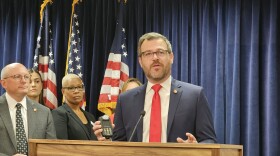A new assessment of Wake County trees values the tree canopy at more than $3.2 billion.
The study showed that each year, Wake County trees are providing free eco-services, absorbing more than 414,000 tons of carbon dioxide. That's in addition to removing over 11,000 tons of pollutants from the air and intercepting billions of gallons of stormwater.
But the trees’ benefits go far beyond that, said Timothy Maloney, Wake County's planning, development and inspections director.
“We all know about the environmental benefits,” Maloney said. “Carbon sequestration. Controlling surface stormwater runoff. But they bring about emotional benefits and well-being to our communities. When we have cleaner air, we have healthier people, and we have happier people.”
However, in the last decade, Wake County lost 11,122 acres of tree canopy, which is more than double the size of Umstead State Park. Maloney said this loss is likely due to the region's rapid development. The county said its population grew to over a million people between 2010-2020, making its growth rate nearly 3.5 times the national rate.
“When we started this study, we knew what the end of the story was going to be like,” Maloney said. “We knew it was going to be a loss of tree canopy. It's not a matter of how we curb growth, but how we manage that growth, and then how we manage that development and balance it with the impacts on our environment.”

Some of the biggest things to come from this study, though, are planting opportunities, Maloney said. The study identified over 80,000 acres of land on public and private property available for planting projects, making sure to exclude areas like recreational fields and agriculture sites.
Of those available sites, a press release listed over 10,000 acres as being “very high planting priority.” According to Maloney, many of these are areas where planting trees would improve social equity. Underserved communities are particularly vulnerable to problems associated with fewer trees, like increased flooding and heat.
The county recently launched a new interactive tool for the general public to explore the tree canopy coverage in their area.
Wake County already has a planting project in the works. County officials plan to plant more than 3,000 seedling trees at an interchange on Highway 54 by January.







